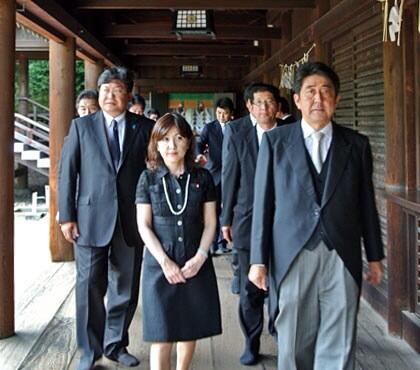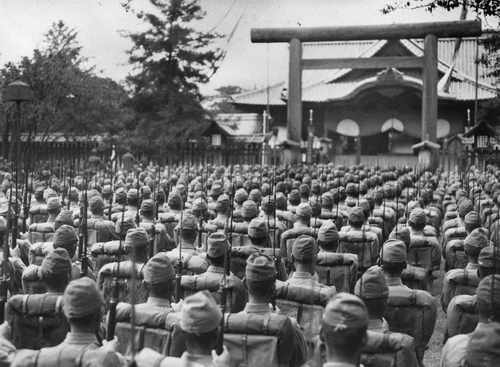Like many foreigners observing the Moritomo Gakuken scandal play out, I am fascinated by the interplay between Shinto, nationalism, and government. There are questions that come with the scandal: Why is it a problem? Why shouldn’t the school use the Imperial Education Rescript? Why is the world watching so carefully? (Originally published in Spring of 2017)
The problem is State Shinto.
Although most Westerners continue to conflate State Shinto and Shinto, they are not the same thing. It is important to note that, although Shinto is mentioned constantly, what is fueling nationalism is not what the Western world would call the “religion.” It is secular Shinto, also known as “State Shinto,” and it is not a religion so much as an ideology. That is why many politicians now feel they can revive it. To the Japanese, it never was a “religion.”
Many international scholars of Japanese history and Shinto have pointed out that there is a significant difference between the two ideologies, but the issue is inherent in the definition of Shinto itself. There is no one definitive definition, which often makes discussing Shinto difficult. One issue, for example, is that scholars have been arguing about when Shinto actually began. There are many Shinto scholars such as D.C. Holtom and Hirai Naofusa who claim that Shinto is aboriginal and began before Chinese writing came to Japan in the seventh century. Meanwhile, scholars like Kuroda Toshio insist that it did not develop until the 19th century, after the burgeoning desire for a national identity and the blossoming of intellectual thought sprouted in Japan.
This is important, of course, because of the aforementioned 19th century intellectual movement’s search for the true “Japanese culture and nature.”[1] Towards the end of the Tokugawa regime, there had been enough peace and stability that Japan had developed a monetary free market–a form of modernization. While they enjoyed the peace of isolation and stability, across the seas, China endured the Opium Wars (1839-1842 and 1856-1860). Although they were not involved, the Japanese received news of how the West had taken over the once-great country, something that made them both contemptuous of China’s weakness and worried that they were next.
These are a few reasons that caused the Japanese began to look back to their roots. Japanese history, however, was not documented prior to the seventh century, when the Chinese writing system was adopted. As such, they only had the great books of mythology: the Kojiki and the Nihon Shoki. Here, again, however, the issue becomes one of intent. Any history book of Japan documents the early days of the writing of the Kojiki and Nihon Shoki as attempts by the imperial family and their high-ranking associates to ensure their lineages were linked to the gods, specifically, in the case of the imperial family, to Amaterasu, the Sun Goddess.
As such, for many Westerners, Shinto is seen as an animistic, shamanistic, beautiful religion, but–in reality–its two definitive books were based on the format of ancient Chinese histories and were written to lay the dynastic foundation we still see today.
Meiji Restoration and Imperialist Japan
The Meiji Restoration through the lens of Shinto is a bit different. Shinto developed through the Intellectual Schools of the late 19th century as a seed of national identity. The late 19th century Japanese clung to the idea of inherently divine genetics and purged the most of the foreign ideologies and religions—such as Buddhism–that had helped develop the country until then. They also sought out Western modernization and pushed the development of Japan from 1868 on to emulate the winning and powerful Western societies the Japanese saw destroying Asia and claiming its wealth. This included dissembling the shogunate and writing a constitution to rebuild the country with Western ideologies.
As such, the Japanese “shunned Asia” and decided to “join Europe” to avoid being swallowed by the Western imperial machine. The driving core, again, was State Shinto, a secular propaganda machine that served to add ritual to activities and indoctrinate from school children up as the Japanese began required, systematic, national education. The glorification of the Emperor became an intrinsic aspect of Japanese life, and it began with the Imperial Rescript of Education.
Let me pause a moment to focus on the term “secular,” as used by Shinto scholars. “Secular” has different meanings in many fields, but secular, as applied to State Shinto, means that it is not religious. The secularity is based on the government use of Shinto to manipulate the population. Shinto, as a religion practiced in Japan, is not secular. And, of course, Shinto, the social philosophy, is not secular as it refers to the spiritual and common beliefs of Japanese society.
I did mention Shinto was difficult to define and its aspects are not easily distinguished. It is reason why the Western use of “Shinto” in its reporting is not a good idea. Abe and the Liberal Democratic Party (LDP), with the Nippon Kaigi (Japan Conference) behind them, are using State Shinto, a propaganda machine.
Allow me to illuminate:
The Meiji Constitution’s key concepts of emperor worship and propaganda intensified in the twentieth century, as the wars (such as the Sino-Japanese wars, Russo-Japanese war, World War I) and expansion required a reevaluation of the basic terms of the Constitution, channeled through the ambitions and emotions of nationalism and ethnic imagination.[2] This developed into questions of the relation of the “political” nation to that of an “ethnic” nation (asserting the Japanese pure ethnicity) and the place of “race” when discussing colonial peoples such as in China and Korea.[3]
By the time World War II and Pearl Harbor occurred, the indoctrination process of Japan having divine blood and blessed land had already been in motion for going on 50 years.
U.S. Occupation
Although bushido is often (anachronistically) referred to as a means of manipulating the Japanese imperial troops, it was State Shinto that was the ideology behind the war. The U.S. recognized Shinto as the core of Japanese national identity and the inherent problem of their determination the deification of the emperor. After the surrender in August 1945, the Japanese desperately tried to shield Emperor Hirohito from any blame, but they could not shield him from being undeified.
Along with the new Constitution by the U.S., there was also the development of the Shinto Directive of December 15, 1945, or the “Abolition of Governmental Sponsorship, Support, Perpetuation, Control, and Dissemination of Shinto.” The purpose of the document was:
“to lift from the Japanese people the burden of compulsory financial support of an ideology which has contributed to their war guilt, defeat, suffering, privation, and present deplorable condition.”
“In order to prevent a recurrence of the perversion of Shinto theory and beliefs into militaristic and ultra-nationalistic propaganda designed to delude the Japanese people and lead them into wars of aggression.”
“In order to assist the Japanese people in a rededication of their national life to building a new Japan based upon ideals of perpetual peace and democracy.”[4]
With this, State Shinto–and all the ideology and policies that accompanied it–were prohibited. Only sect or local Shinto was allowed, given the same protections and freedoms as the other religions for private practice.[5]
But State Shinto is not a religion.
Contemporary Japanese scholars–such as Shinto Scholar Isomae Jun’ichi and religion scholar Shimazono Susumu–have argued that State Shinto has never gone away.[6] Because the U.S. described a “religious” State Shinto in the Shinto Directive, it failed to abolish it as it was never religious but secular.[7] In the broader sense–as defined by religion scholar Murakami Shigeyoshi–State Shinto refers to the combination of State, Imperial, and the ideology of the national essence (kokutai). In finer terms, it basically includes the prewar emperor system and its ideology of “national morality.”[8]
Why this matters now?

Just recently the LDP had announced that the Imperial Rescript on Education was allowed to be taught in school.[9] The problem with allowing this is that the Imperial Rescript on Education was used to indoctrinate school children in the Meiji and Taishō eras of Japan. Now, with the Moritomo Gakuen and their schools being examined for their ultranationalist leanings, it is important to see the stance the LDP has overall taken in terms of trying to reignite the nationalist and nativist spirit of Japan. Most Westerners are not aware of Article 14 of the Basic Education Law that stipulates “that schools, including kindergartens, must not conduct political education or other political activities that support or oppose certain political parties.”[10]
Note that the Imperial Rescript on Education not only asks for morality and purity, but it also “called on the people to serve the imperial nation, especially in sacrificing one’s life when Japan faced a major crisis.”[11] A copy of the rescript used to hang in school and the public had to bow to it, as it was the emperor’s words and very closely tied to State Shinto. Now, the rescript is understood to have been used to unify the people under the deified emperor and encouraged the totalitarian state of World War II: Pacific Theater.[12] Because of that, parliament passed resolutions in 1948, confirming that “the rescript should be abolished because it violated basic human rights.”[13] For this fact alone, Moritomo Gakuen and its director, Kagoike Yasunori, are both being investigated. The school scandal also spread to the current parliament, as Defense Ministry Inada Tomomi also defended the rescript as a “good thing.” But this perspective is not surprising when both she and Kagoike are also known to be members of Nippon Kaigi. As a result, the organization is again in the spotlight, not just in Japan, but internationally.
It is because of these issues that it is problematic, in my opinion, to conflate the spiritual entity known as Shinto and the secular nationalist propaganda machine that is State Shinto in the media. The West needs to reevaluate its use of the word, because we are careful to say “militant fundamentalists” when referring to radical Muslim or Christian ideologues. State Shintoists are of the same ilk: fundamentalist nativists who want to make Japan “great” again. It is an indoctrination machine the world needs to keep an eye on.
Irene Unpingco currently lives in Las Cruces, NM, USA, and works at New Mexico State University’s History Department. Her interests include following Liberal Democratic Party (LDP) activities in State Shinto, and she is working towards her PhD in Asian History.
[1] There are two schools: Mitogaku (Mito school) and Kokugaku (National learning school) where the intellectual schools flourished from and spread nativism.
[2] Helen Hardacre, Shinto: A History, New York: Oxford University Press 2016, 406.
[3] Ibid.
[4] Shinto Directive, PDF, Nagoya: Nanzan Institute for Religion and Culture, 1.
[5] Sect Shinto is based on the teachings of certain Schools during the Tokugawa era; local Shinto is private practice Shinto.
[6] Jun’ichi Isomae, “Deconstructing “Japanese Religion”: A Historical Survey,” Japanese Journal of Religious Studies, 32nd, no. 2 (2005): 235-48. Accessed March 13, 2017. doi:10.18874/jjrs.32.2.2005.235-248, 239.
[7] Ibid., 26.
[8] Ibid.
[9]Osaki Tomohiro, “Imperial Rescript on Education making slow, contentious comeback,” The Japan Times, April 11, 2017, accessed April 17, 2017, http://www.japantimes.co.jp/news/2017/04/11/national/imperial-rescript-education-making-slow-contentious-comeback/
[10] Kenichi Mizusawa and Takashi Ishihara, “Kindergarten ‘crossed line’ by teaching pupils to cheer for Abe:The Asahi Shimbun,” The Asahi Shimbun, February 28, 2017, accessed March 22, 2017, http://www.asahi.com/ajw/articles/AJ201702280087.html.
[11] Ibid.
[12] Ibid.
[13] Ibid.
